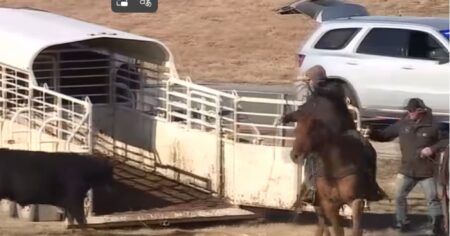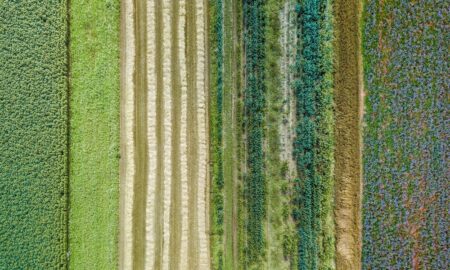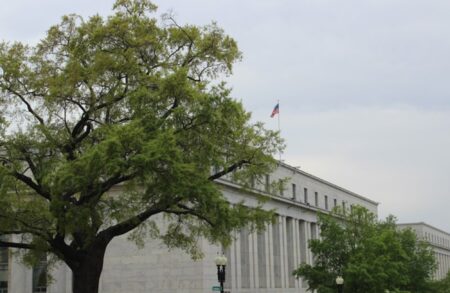USDA recently signed an agreement with the Department of Justice to protect farmers from high and volatile input costs. Andy LaVigne, president and CEO of the American Seed Trade Association, joined Agri-Pulse Newsmakers to discuss the announcement and seed costs. Plus, he explained how tariffs are impacting the seed industry and ASTA’s recent acquisition of the Biotechnology Innovation Organization’s crop biotechnology advocacy portfolio.
Plus, Jay Vroom with Vroom Leigh Agriculture and Peter Carstensen with the University of Wisconsin discussed farmers’ concerns about consolidation in the inputs space and the differences between the Trump and Biden administrations’ work on ag industry consolidation.
Watch the Video
Want to receive Newsmakers in your inbox every week? Sign up!
Read the Transcript
Please note: This transcript has not been edited.
Lydia Johnson: Welcome to Agri-Pulse Newsmakers, where we aim to take you to the heart of ag policy. I’m your host Lydia Johnson. Our guest this week is Andy LaVigne, president and CEO of the American Seed Trade Association, who joins us to discuss input costs, how tariffs are affecting the seed industry, and the group’s recent acquisition of the Biotechnology Innovation Organization’s crop biotechnology advocacy portfolio.
But first, here’s this week’s headlines.
- The Trump administration released a 13-page plan outlining steps to boost domestic cattle production and beef consumption while lowering retail prices. The plans action items are intended to induce producers to expand herds while reducing regulatory costs, including reduced overtime fees for USDA inspection of small-scale processors. It also calls for opening up 24 million acres of unused grazing allotments on Forest Service and Bureau of Land Management lands. The announcement comes at the same time the White House has angered producers and many GOP lawmakers with Trump’s idea of boosting imports of Argentinean beef. On Wednesday, Trump posted on social media that cattle producers were only doing well because of his tariff policy. In reality, cattle and beef prices have remained relatively high since before he took office because of historically low cattle numbers.
- The government is still shut down, but the Agriculture Department has decided to distribute commodity program payments, resume farm loan processing and reopen FSA operations. About two thirds of FSA employees were furloughed when the government shut down at the beginning of the month. Farmers will be getting their agriculture risk coverage and price loss coverage, crop insurance payments that are typically distributed in October. Nearly $2 billion in ARC payments and over half a million in PLC payments are expected to be made this year, according to the University of Missouri’s Food and Agricultural Policy Research Institute.
- The U.S. ethanol industry is facing a major setback in securing access for year-round E15. The American Petroleum Institute, a powerful organization in the oil lobby, withdrew support for legislation to allow year-round sales of higher blends of the corn-based biofuel throughout the country. API’s prior support had been heralded as a breakthrough in relations between Big Oil in the agriculture sector, which has spent most of the last couple decades, and fierce lobbying battles over fuel policy.
USDA recently signed an agreement with the Justice Department to protect farmers from high and volatile input costs. We asked Andy LaVigne, president and CEO of the American Seed Trade Association, how the announcement could affect the seed business.
Andy LaVigne: Well, the Department of Justice has been looking at the seed industry, along with other ag input sectors, for a number of years and starting under the first Trump administration, moving to Biden and now continuing on with the second Trump administration. Really, what they’re looking to see is are there any unfair practices there and any antitrust practices of concern? Again, they’ve been looking at this for about eight years, and we have not seen anything yet. They haven’t come out with anything, detrimental to the industry. The industry strives to be competitive and provide the American farmers the highest quality seed possible.
Lydia Johnson: AG Secretary Brooke Rollins says that seed costs have risen about 18% since 2020. I mean, that’s a pretty significant amount.
Andy LaVigne: Yeah, it is. I mean, one of the things that we look at, though, is from the standpoint of seed, we bring new varieties to market every single year. And so, we’re investing money every year so that farmer has new products. And the secretary chose to look at the nominal value of the seed over that five-year period. If you look at the inflation-adjusted seed over five years or ten years, it’s flat, whereas inflation adjusted for the American dollar, it’s about 3.35% a year. And so, when we’re making the investments we’re making and the farmer’s pretty much getting that seed at the same cost every year, that’s a pretty good deal. You know, we’re partners in this effort with the farmer. And so, we believe that the more accurate number to look at is that inflation-adjusted number, and that’s what we look at in just about everything in our economy.
Lydia Johnson: And you mentioned those investments that, you know, the seed industry makes in developing new varieties. Can you kind of detail that R&D pipeline? I mean, the timeline and the cost investments that go into that?
Andy LaVigne: Well, we estimate — a number of universities have estimated that the U.S. seed industry spends about 15% of its revenue on an annual basis in developing new seed technology. That could be treatments, it could be new genetics, it could be biotechnology traits. And so, all of that goes back into producing that professionally produced seed every single year for America’s farmers. And we look at, just a conventional variety, whether it’s a grass variety or a vegetable variety, or a corn, just that variety itself takes 8 to 10 years because you have to go through testing and evaluation, you’ve got to go through multiplication, and then you have to bring it to market. And if you’re dealing with a biotechnology product, it’s about $115 million in about 15 to 16 years to go through the whole testing and evaluation, introgressing the traits into the various varieties and then bringing it to market. On top of that, you have to go through the regulatory process and that process is here in the US and then in all of our major markets for grain. And so, we have to ensure that those markets will accept the grain with those new traits in it. And so, it’s a pretty extensive process, to bring new products to market.
Lydia Johnson: Seed companies make large investments in developing new varieties. We asked Andy Levine, the president and CEO of the American Seed Trade Association, if he sees a correlation between seed prices and the price farmers are receiving for crops.
Andy LaVigne: Yeah, we don’t look at it from that standpoint. The data that we use is the same data that the secretary used from the Economic Research Service at USDA, and so we’re not looking at it and we’re not doing any comparisons in the marketplace. And that investment is done on a just an annual basis looking forward. Because we’re planning a crop, this year’s seed crop for corn will be harvested this fall, right now, will be conditioned, and then it will be brought to the farmer next March or April to be planted. And so we’re always planting a crop. Our crop happens to be seed. And we have the same vagaries of the, the environment and Mother Nature, the input cost. We’re farmers. Seed companies are truly farmers because you have to plant the seed to grow the crop. Our crop happens to be seed. Those prices don’t fluctuate when the market is high or when the market’s low, because we’ve got all of those input costs in into the process to bring that high quality professionally produced seed to farmers.
Lydia Johnson: And, you know, I want to pivot gears a little bit. Tariffs are also affecting agriculture very broadly right now. But how have you seen those tariffs impact the seed industry. And you know, especially in the seed industry where many things are imported or even tested abroad?
Andy LaVigne: Yeah, that’s the key thing for us is a lot of our products are tested and moved throughout the world. And to ensure that the products will work, whether it’s in North Dakota or whether it’s in Florida. So, you’ve got a wide diversity of, of environmental, standards that are required for that seed to perform. And so how do we make sure that happens? So we’ll be in Chile in the winter here in the U.S. when it’s spring and summer down there, and then we bring the seed back. Or we bring the seed to Europe and we bring it back. We estimate that with a tomato seed, it’s going to go five different places around the world before we condition and process it in California and distribute it to farmers. And so having those tariffs, every time it crosses the border in or out of the U.S., the farmers are likely paying a tariff, especially in today’s environment. We know a couple of our companies that have had up to a $300,000 bill on seed just for bringing a seed in from places around the world when they’ve got to multiply that seed. We can’t always multiply or research seed in the US. So, we have to have that broad spectrum of opportunities throughout the world to do that. And so, our companies are estimating we’re going to spend, several million dollars this year just in bringing seed to America’s farmers.
Lydia Johnson: And so naturally, I mean, that cost could be passed along to farmers, right?
Andy LaVigne: Yeah. It’s, we’ve been dealing with it for a number of years, and the seed companies have done their best to try to, you know, just soak, suck that up in, you know, not pass it on to farmers. But at some point in time, it’s going to have to be passed on to farmers, depending on where the seed is produced and what, what type it is.
Lydia Johnson: And as we wrap up here, I also want to get your thoughts. The American Seed Trade Association announced this week that they would take up the crop biotechnology advocacy portfolio after the Biotechnology Innovation Organization dissolved, the ag and environment section earlier this year. I want to get your thoughts on, you know, what’s the impact of this announcement and why does it remain important to continue advocating in this space?
Andy LaVigne: Well, when we look at it, we’ve always represented and we say we always represent all crop production types. So conventional biotech and organic, you know, our companies choose what products they provide for their farmers and farmers choose what they’re going to produce on their operation. It could be biotech crops. It could be organic crops, conventional crops. So the seed industry provides that high quality genetics for it. We consider biotechnology a breeding method. And so we really are excited about bringing the whole biotech portfolio into asters, activities. We have worked, side by side with bio over the years as products have come to market. They have dealt with the regulatory side of it and the international side. We’ve dealt with more in the field and beyond. We see this now as picking up that regulatory side and the international components, and then also working with the downstream partners, you know, the growers, the grain trade and the food processors that have interest in biotechnology.
Lydia Johnson: We’ll be back with more newsmakers. But first Parker Litterick looks at farm input expense estimates. And this week’s Ag By The Numbers.
Parker Litterick: Farmers are struggling with another season of low commodity prices, and some producers are blaming their higher production costs on consolidation in the input market. Experts say consolidation isn’t the only factor driving up input prices. AG economists say other drivers of price increases include increased demand and the high cost of building domestic production facilities. This chart shows farm input expense estimates from 2015 to 2025, according to the USDA’s Economic Research Service. Fertilizer and fuel both saw a significant spike in 2022 and now check in at around 34 and $16 million, respectively. Meanwhile, seed and pesticides have slipped slightly to about 27 and $21 million in the last year, and electricity remains steady at around $8 million. For Agri Pulse, I’m Parker Litterick.
Lydia Johnson: Welcome back. The Justice Department and USDA recently signed an agreement to protect farmers from high and volatile input costs. We’re joined by Jay Vroom with Vroom Leigh Agriculture and Peter Carstensen with the University of Wisconsin, and our panel this week. Jay, we’ll begin with you. What do you make of this announcement? And could it really bring down input prices for farmers?
Jay Vroom: First of all, I would say, as farmers and those of us in the ag input sector, we always welcome, transparency and engagement with government and on these kinds of subjects, which obviously are sensitive, particularly given the Sherman Antitrust Act. We all want to be careful about, exactly how we engage on these topics. But, the strength of American agriculture has always been grounded and strong competition. Lots of competitors and and clear and transparent markets. So I think, we have hope that, this will show opportunities, but also how strong competition and innovation has been in this U.S. marketplace, for crop inputs.
Peter Carstensen: And, Peter, I want to bring you into the conversation. You know, cracking down on competition isn’t something new. Former Secretary Tom Vilsack worked on this issue during both the Biden and, Biden and Obama administrations. You know, what’s the difference about when you look at that approach to this administration’s approach? What differences do you see? Well, it looks to me like they want to reinvent the wheel. There was an ongoing, project, especially with respect to seeds, that, was one that was developing the information necessary for critical review of a variety of contractual terms that arguably, and in the view of many, well, resulted in higher prices and reduced, opportunity for competition in the production and distribution of seeds. So, you know, they terminated that project, back in July and then discovered that there were serious questions about the price of seeds. And I’m focusing on that in particular, because that was emphasized in the, in the press release, to again, suddenly to restart with mou involving only the Justice Department and the USDA, rather than including, Federal Trade Commission that has oversight in some of the related areas, like pesticide, like, pesticides and fertilizer, and ignoring the patent office, whose construction of how what is patentable, how it can be patented is, again, very, very central to the competitive process.
Lydia Johnson: And former Secretary Tom Vilsack has said that transparency is key to keeping these input prices low for producers. You know, I’m curious, is greater transparency in this space possible or how could that be possible?
Peter Carstensen: Oh, yes. Many of the contracts that exist are subject to confidentiality requirements. There are significant restrictions on what independent seed companies can do that need to be made again, much more transparent, much clearer to the general. Community and to law enforcers in particular. I’m not saying that these contracts are necessarily illegal, but it is important that they be looked at, and examined, much more thoroughly than they seem to have been.
Lydia Johnson: Many inputs operate in a global market. We asked Jay Vroom with Vroom Leigh Agriculture when tariffs could begin impacting input costs for farmers.
Jay Vroom: One of the things that I think, may have been overlooked in this current moment is the length of some of the supply chains and the fact that, tariffs that maybe have started to be imposed in early 2025 May not catch up to the actual retail Ag inputs market until 2026, just because of the natural delays and the need to have inventory for that once a year transaction for those inputs. So the other thing is that, so many of our inputs aren’t just a single ingredient. Certainly that’s true with regard to nitrogen fertilizer. That’s a single ingredient. But then you think about how many different forms of nitrogen fertilizer do I even use on my farms in Illinois? And it’s 4 or 5, in a normal course of 2- or 3-year period. So, and that gets even more complicated with crop protection products. Seeds, also have lots of different inputs and different kinds of licensing, impacts with regard to the constituents that might be in that genetic, profile. And then you add seed coatings and seed treatments on top of that. And all of a sudden the factors around things that may have been in inventory for a year or two that aren’t touched by tariffs, and all of a sudden in next year’s supply, we have tariff impacts can be quite a jolt.
Lydia Johnson: Very interesting to a longer-term thinking when we look at the tariff impacts there. And Jay, there’s kind of a rhetoric some farmers are blaming industry consolidation for the high input prices right now. I mean, do you think that this is a valid argument?
Jay Vroom: Certainly. It’s a factor to be part of the conversation. I think it’s not correct just to say that consolidation has the potential for increasing costs. In a lot of cases, consolidation means the suppliers have greater scale and can actually bring costs down. That certainly was the conversation around some of the consolidation reviews that were undertaken by Congress and the federal government. And, the crop protection and seed sector back in the late, 2018, 2019, 2020 period. So, I think it can cut both ways. And at the end of the day, if we have enough transparency and enough competitors, I think we as farmers, ought to feel assured that, along with government oversight, that, we will get a good deal.
Lydia Johnson: Peter, I want to get your thoughts as well. I mean, can industry consolidation be blamed for these input prices? It’s interesting, you know, sometimes these prices will go up with the price of crops, but they don’t always come back down on the on the other side when crop prices go back down.
Peter Carstensen: It’s important to remember that the objective of business is to make a profit, not to conduct a charitable operation for farmers. So, if you got a concentrated industry that, in some way may reduce its production costs, that does not in any way guarantee that they’re going to share any of those cost savings with their customers if they don’t have to. And that directly implicates the number of competitors in the market. I do want to acknowledge we’ve had an extraordinary improvement and a whole variety of seeds, of plants, corn, soybeans, cotton, etc. they have this is really significant. It did not require does not require the level of concentration that we have in use in these industries. And I’m particularly concerned about the ways in which patent law is being used to frustrate innovation, developing new, improved varieties based on the new technologies.
Jay Vroom: The other side of the truth is that certainly here in the United States, we are seeing longer and longer approval times, required to get licensing, approval from U.S. EPA for new pesticide and crop protection technology that has eroded patent life. And so that’s cut the other way. Very much so. And that’s true in a lot of other developed markets around the world. So again, we as farmers need to be aware of all these dynamics.
Lydia Johnson: We’ll be back with more Newsmakers. But first Parker Litterick looks at state SNAP purchasing restrictions. And this weeks Map It Out.
Parker Litterick: A growing number of states are requesting approval from USDA to restrict purchases of soft drinks, candy and desserts through the supplemental Nutrition Assistance Program. So far, the Agriculture Department has approved a dozen waivers, and four states are still waiting for final approval. Current proposals vary significantly, both in complexity and in types of products covered. This map shows a number of states looking to ban the purchase of soft drinks using SNAP benefits. There is variation between states. For example, Oklahoma looks to ban naturally or artificially sweetened beverages, including flavored water. Louisiana is cutting carbonated beverages but exempts flavored carbonated water. States including Indiana and Idaho want to ban candy from SNAP eligibility, as well as soft drinks. Both states have different restrictions, with Indiana’s covering most varieties in Idaho exempting all candy-containing flour. This means that SNAP recipients could use their benefits to purchase a Twix bar in one state, but could be barred from doing so in another. Florida is the only approved state as of now that’s seeking to ban prepared desserts from SNAP purchases. Florida defines prepared desserts as shelf stable, ready to eat, prepackaged sweet food. Brandon Lipps, administrator of the USDA Food and Nutrition Service during Trump’s first term, told agriculture that the convergence of the Make America Healthy Again movement with the nutritional interests of Democrats is helping drive these restrictions forward with bipartisan support. For Agri-Pulse, I’m Parker Litterick
Lydia Johnson: Thanks for joining us for another episode of Agri-Pulse Newsmakers. The government remains partially shut down, but the Senate Judiciary Committee has scheduled a hearing Tuesday on competition in the seed and fertilizer industries. Tune into newsmakers next week and check our website any time for the latest developments on all things food, farm and fuel policy. For Agri-Pulse, I’m Lydia Johnson. Thanks for watching.
Agri-Pulse is a trusted source in Washington, D.C., with the largest editorial team focused on food and farm policy coverage.









:max_bytes(150000):strip_icc()/soybeans-down-7d23272bd031487b908c22b63639473a.jpeg)

:max_bytes(150000):strip_icc()/MayWheatRainDrops-1-731120a608ab4b9c8576aeff53d5ff5f.jpg)
